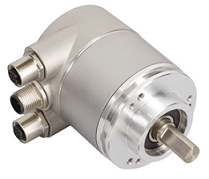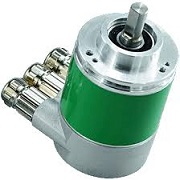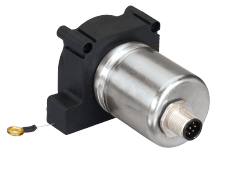Absolute Encoders

These instruments contain a material representation which allows a direct read-out of the angular position, because of which these encoders are called Absolute Rotary Encoders. Encoders with a mechanical store (gear, drive) also acquire the amount or absolute revolutions.
Absolute encoders produce a specifically coded value for each shaft position. Absolute encoders assume the task of counting from coupling devices, especially with regard to positioning functions, so that extensive and costly input modules can be eliminated. In addition, reference speeds are eliminated with the activation of the machine or after the loss of supply voltage, since the current position information is immediately available.
Absolute encoders come in two varients:
- Magnetic
- Optical
Incremental Encoders

Incremental encoder shows that these encoders work by summing up electrical pulses. To evaluate the measure of length a counter, a PLC-Interface or similar is used. If we look at the frequency itself and not at the individual pulses it is possible to deduce from it directly the revs or the speed.
Incremental encoders deliver a specific number of signals per shaft rotation. The measurement of the cycle duration or counting the pulses per a specific time interval indicates the speed of a motion. If the pulses are added according to a reference point, then the count represents a measure for the marked angle or the distance covered.
In addition, three-channel incremental encoders produce a so-called zero pulse (marker pulse) once per rotation.
LINARIX Linear Sensors

Many applications require linear motion to be monitored for system control or to ensure safety. With lengths ranging from 1 m to 10 m (3’ to 33’), LINARIX draw wire sensors are available in many configurations to meet an application’s requirements. Options include a wide variety of outputs (including analog, fieldbus and Ethernet variants), heavy duty housings and compact designs.
Features:
- Wide Selection of Measuring Lengths 1 to 10 m (3' to 33')
- Absolute Position Measurement with Resolutions up to 2 µm
- High Linearity even with Long Cycle Times
- Low Cost yet Rugged Construction
- Scalable Analog Output to Fit Measuring Length

